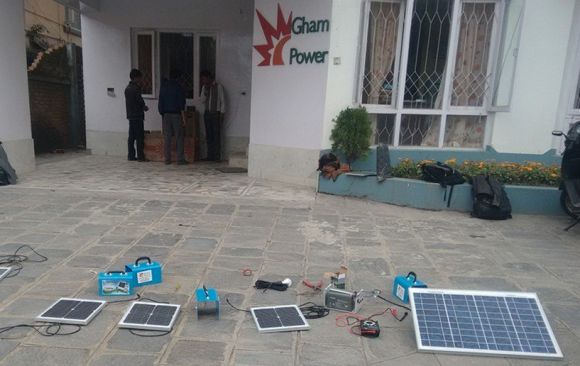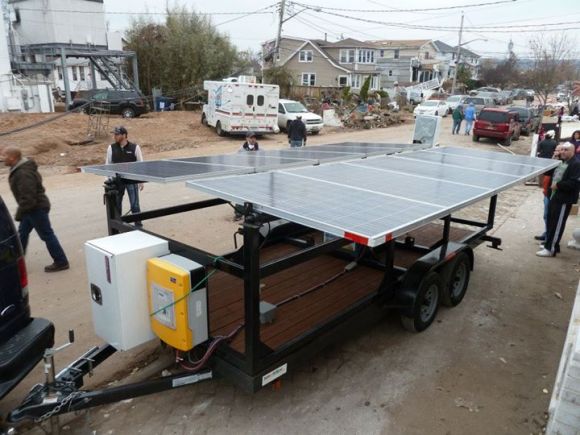Avishek Malla is no stranger to bringing solar-powered light to communities in need. As the director of engineering for SunFarmer, a nonprofit that provides solar power and batteries to remote hospitals and schools in developing countries, illuminating spaces to meet basic human needs is in his job description.
One of Malla’s most recent tasks was a different kind of challenge. In the aftermath of the 7.8-magnitude earthquake that leveled much of Nepal’s capital city of Kathmandu, Malla was out on the street fixing a solar streetlight to give his neighborhood some light after two days without power.
But Malla and SunFarmer want to do much more than fix a few streetlights. Along with colleagues Kushal Gautam and Sneha Bhandari, Malla is trying to collaborate with non-governmental organizations (NGOs) to help bring solar water purifiers and small solar-powered systems, under 200 watts, to villages in the hills hit hardest by the earthquake. There are an estimated 1.4 million people in need of immediate help.
“Everyone is on edge,” said Amanda Eller, marketing and operations manager for SunFarmer, of those on the ground in Nepal. With a traumatized population that has dealt with more than 100 aftershocks and new earthquakes, deploying novel technology is a monumental task.
A cleantech void in disaster relief
Many of the challenges that SunFarmer faces are not unique to Nepal or the current crisis. Clean energy technologies, especially solar-powered generators, seem like a logical choice during disaster relief efforts, as they do not require fuel supplies to be shipped in. Unlike more traditional technologies such as diesel generators, however, they are often not considered by NGOs during the planning process and are not warehoused and ready to go when emergencies happen.
The cleantech sector needs to work more cohesively with large NGOs and local stakeholders before disasters happen, say professionals in the field. In some cases, that would involve rethinking how the organizations use power during a crisis, what standard equipment and interconnections look like, and how clean energy could scale in a disaster.
“This is a big ask of the NGOs, even in non-crisis situations,” said Zach Lyman of Reluminati, a cleantech consulting firm.
For starters, off-grid solar systems or microgrids that are used in "blue-sky" conditions are not even close to what is needed right after a disaster. SunFarmer, supported in part by SunEdison, usually deploys 2-kilowatt systems with battery backups to remote hospitals.
“What assets can you put in place that provide economically viable power every day to the community, but are part of resilient architectures when the earthquake hits?”
“We can’t just send out the components of a 2-kilowatt system,” said Eller. Instead, SunFarmer has been locating warehouses with 100- to 150-watt systems. The nonprofit also hopes to bring in twenty 200-watt systems donated by SunEdison from India to be used in health clinics. SunFarmer has donated $25,000 of its own funds and has collected donations, largely from the cleantech community, with the goal of helping 100 health clinics in Nepal affected by the earthquake meet their basic needs.
Getting shipments through the airport is not being considered in the short term, as the airport is already overwhelmed and the government is controlling what can come in and out. Lyman said that every time there is a disaster, he is contacted by scores of well-meaning people in the solar industry who want to donate units, but “typically, that is a terrible idea.”
“In order to really make this a viable option here in the U.S. as well as globally, it's going to take a determined manufacturer a good amount of time and money to travel, speak to people, do demonstrations, ship units around the country and world, and generate awareness,” said Chris Mejia of Consolidated Solar, whose company provided mobile solar generators after Superstorm Sandy.
Starting small with solar
SunFarmer was well positioned to try to coordinate solar assets for the relief effort because it already had staff on the ground that understood local supply chains and stakeholders. “We want to be mindful of not spending money on anything but what’s needed,” Eller said of SunFarmer’s response efforts, even if that was diesel generators. “We’re not above that,” she said of supporting diesel backup, “but that just wasn’t the right technology.”
Instead of trying to build relationships with large NGOs, SunFarmer started with the organizations it already had a history with, including Practical Action, American Nepal Medical Foundation and One Heart World-Wide, all of which have a long history in Nepal and in some of the areas most affected by the earthquake.
SunFarmer’s staff kept hearing that water purification was one of the most pressing needs, so they began looking for solar-powered water purification that could be brought over land from India. When that proved to be too time-consuming, they began assembling their own by connecting purification devices to small plug-and-play systems they already had sourced in-country.
Water is critical, but the most important technology in the domain of clean energy disaster relief is the solar lantern. In the wake of the Haiti earthquake in 2010, D.light provided tens of thousands of solar lanterns. In Nepal, the United Nations High Commissioner for Refugees (UNHCR) has sent out 8,000 solar lanterns to Kathmandu and the hilly districts of Ramechhap, Okhaldhunga and Sindhuli. SunFarmer is helping to coordinate distribution of solar lanterns from D.light and others and also the 100- to 150-watt systems for medical tents and community centers. Gham Power, a solar microgrid company in Nepal, is also deploying solar lights and providing charging services to rescue workers and communities.

Employees of Gham Power prepare basic solar lights and charging services for rescue workers in Nepal. Source: Gham Power
Although solar lanterns are commonly used, “they are profoundly under-valued, specifically for their ability to charge mobile phones to support ongoing communication in areas affected by electrical loss,” said Daniel Tomlinson, an access-to-energy entrepreneur and co-founder of Frontier Markets.
One global player that has tried to bring solar and LED technologies to a major NGO is the Ikea Foundation, which has provided millions of dollars to the UNHCR for solar lanterns and street lights in refugee camps.
Even for an international powerhouse like Ikea, building comprehensive, disaster-ready solutions requires significant investment. Ikea engineers and the UNHCR spent years developing the flat-pack Better Shelter, a temporary shelter with a lifespan of three years that can be used for disaster victims and refugee camps. UNHCR has committed to buying 10,000 of the units.
Equipped with a solar light, “it is designed with special attention to transport volume, weight, price, safety, health and comfort, and it can be assembled on site without additional tools and equipment,” Ikea said in a statement.
A more resilient power system
The immediate need for clean water and basic power is acute in Nepal, but as in many other developing nations, it will take years to recover from a natural disaster of this scale. As Nepal cobbles its power system back together in the capital, it has an opportunity to think about the improved resilience that distributed clean energy solutions can provide. Those are questions not just for developing nations, but for every region in the aftermath of a disaster.
In the wake of Superstorm Sandy, the mid-Atlantic states that were hardest hit began investing in strategically located microgrids to keep critical facilities functioning in the case of another disaster. But the price for such systems remains high, and smaller, more simplified solutions will be needed in regions that were already suffering from energy poverty before a natural disaster.

Solar generators were used to help New Yorkers after Superstorm Sandy. Credit: Consolidated Solar
“Even though we’ve started with quick relief, we’re also keeping an eye on longer-term reconstruction,” said Eller. Many of the hardest hit areas in Nepal did not have reliable electricity before the earthquake, so any solar assets deployed now will continue to be of value as rebuilding begins.
SunFarmer is working with NGOs like Winrock to ensure that the larger solar PV systems will ultimately end up in a health facility or school. In many regions, organized agricultural cooperatives will have responsibility for the solar system to ensure it ends up where it is meant to be.
“What assets can you put in place that provide economically viable power every day to the community, but are part of resilient microgrid architectures when the earthquake hits?” asked Reluminati's Lyman. “This is the future of cleantech in disasters, and it will be huge -- both internationally and domestically.”


